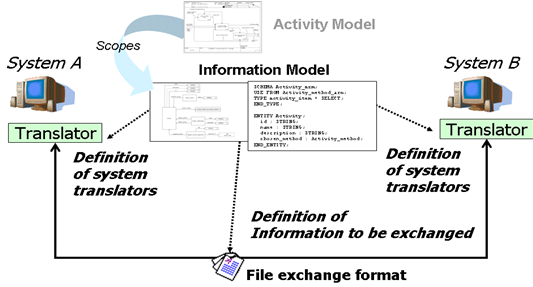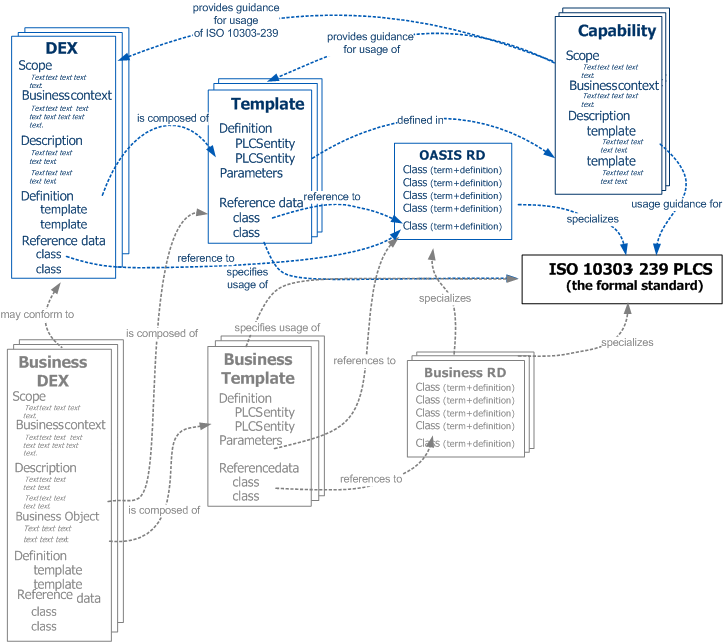 PLCS
PLCS (Product Life Cycle Support)
standard and key components for its use:
(Product Life Cycle Support)
standard and key components for its use:
| Help TOC > PLCS technical description | |
| PLCS technical description | Date: 2010/03/26 17:58:41 Revision: 1.31 |
This technical description provides an introduction to the ISO 10303-239 PLCS
PLCS (Product Life Cycle Support)
standard and key components for its use:
(Product Life Cycle Support)
standard and key components for its use:
These components and their relationships are described and an account of how these components may be further specialized
by others is provided.
Brief descriptions of the DEXlib development environment and the publication status procedures used are also given.
development environment and the publication status procedures used are also given.
ISO 10303-239 (PLCS) specifies the information required to support a product throughout its life.
It is one of the ISO 10303 family of standards, generally known as STEP
family of standards, generally known as STEP (STandard for the Exchange of Product model data.
This family of standards includes the Application Protocol
(STandard for the Exchange of Product model data.
This family of standards includes the Application Protocol s (APs) which define particular business viewpoints of a common information model, and the PLCS standard belongs to this series.
APs are numbered sequentially within STEP. PLCS is AP number 239 and is therefore sometimes referred to as AP239
s (APs) which define particular business viewpoints of a common information model, and the PLCS standard belongs to this series.
APs are numbered sequentially within STEP. PLCS is AP number 239 and is therefore sometimes referred to as AP239 or as "ISO 10303-239".
or as "ISO 10303-239".
The scope of a STEP AP is initially described in an Activity Model , using the IDEF0
, using the IDEF0 modelling language, which
defines the activities and information flows between activities that the AP can support.
The activity model is informative rather than normative.
modelling language, which
defines the activities and information flows between activities that the AP can support.
The activity model is informative rather than normative.
ISO 10303-239 PLCS is intended to "provide through life support for product". The activity model defines four major activities:
These are further decomposed and analysed in the more detailed layers of the Activity Model.
The Activity Model that has been developed for a STEP AP serves as the basis of an information model which represents the information produced by or used by the activities described in the Activity Model. It is this information model that provides a formal representation of the data structures that are shared or exchanged during the life cycle of a product. The information model is normative. This is illustrated in Figure 1 which shows how a STEP AP defines the scope of the information to be exchanged or shared, and offers a range of exchange formats independent of technology to support that exchange. These formats define the requirements for translators applied to specific systems.

The information model of ISO 10303-239 PLCS is capable of representing all the information required to cover the entire life cycle of a product. It is not however, aimed at any particular business or industry domain. Because it is designed to be used in many different business applications, it is a large, generic information model. Whiles this fact ensures that ISO 10303-239 PLCS has a wide range of application, this also implies that that different users will focus on different (though overlapping) areas of the model; and that different users, with different information requirements, may interpret the information model in different ways. In order to address these considerations, the PLCS community has developed a number of mechanisms for partitioning the information model into smaller components and for providing additional (and more precise) semantics that add business specific terminology.
The PLCS community (through the OASIS PLCS TC ) has identified:
) has identified:
 s (DEXs).
They are built from reusable components (called Template
s (DEXs).
They are built from reusable components (called Template s) that ensure interoperability between DEXs.
s) that ensure interoperability between DEXs.
 that provides greater semantic context to the ISO 10303-239 PLCS
model and which may be further tailored to particular business needs.
The set is stored in a Reference Data Library
that provides greater semantic context to the ISO 10303-239 PLCS
model and which may be further tailored to particular business needs.
The set is stored in a Reference Data Library (RDL).
(RDL).
The need for precise semantics exists at different levels, from the business independent semantics and guidelines
provided by OASIS PLCS TC,
through business domains (e.g. automotive, aerospace, military), down to specific projects.
It is anticipated that the same process (using DEXs, RD, and usage guidelines) is applied at all levels,
and that all users of ISO 10303-239 PLCS will take advantage of the starting point given by the work within OASIS
PLCS TC.
This document makes a distinction between the domain-independent components of PLCS
(published by OASIS PLCS TC) and components that are business dependent (published by other groups).
The intention is that the independent components (e.g. PLCS DEXs,
Templates, and the OASIS PLCS RD) will be specialized into more business
dependent components (Business DEX, Business Template s, and domain specific RD).
s, and domain specific RD).
The development environment for all of these components of PLCS is called "DEXlib".
ISO 10303-239 (PLCS) specifies the information required to support a product throughout its life.
This specification uses the EXPRESS modelling language
and provided a basis for the representation, exchange, and sharing of the relevant information.
modelling language
and provided a basis for the representation, exchange, and sharing of the relevant information.
The fundamental data structures of this model are the EXPRESS "Entities". For example, in PLCS there are Entities defining Parts (Part), versions of parts (Part_version), and people (Person). Each Entity may have attributes that provide further information about the thing being represented by an Entity. For example, a person has a first name and last name. Two of the attributes of the Person are "first_name" and "last_name".
Because the information model defined by ISO 10303-239 (PLCS) has a scope that is wider than most applications or any single data exchange, it is unlikely that any single software application will be able to declare compliance to the whole of PLCS. It is would also be difficult to contract for data to be provided according to the whole of ISO 10303-239 as the scope is so large.
The DEXs (Data EXchange specifications) address this problem by providing a way of narrowing down the scope of the information model to be used in any given exchange.
There are a number of data structure patterns of the PLCS model that will be common to many DEXs. (e.g. the representation and assignment of dates and times). Rather than each DEX replicating the detailed specification of these data structures, "Templates" are defined for common elements of the model and are reused across different DEXs. One DEX will be composed of many Templates, and one Template will form part of many DEXs. The reuse of Templates ensures that different interpretations of equivalent concepts in different DEXs are avoided.
Templates are defined within "Capabilities" which, collectively, provide a complete usage guide for the PLCS model.
Each Template has just one defining Capability , but each Capability may define one or more Templates.
, but each Capability may define one or more Templates.
The information model defined by ISO 10303-239 (PLCS) is generic and does not employ business specific terminology. Additional semantics may be represented by extending the entities of the generic PLCS information model through classification with so called "Reference Data" (RD). This provides a mechanism for adapting the model to the semantics of more specialized domains.
In summary:
The PLCS DEX architecture is shown in Figure 2, and comprises:

The PLCS architecture is extended to encompass specific industrial domains by the following components:

The development environment for all of these components of PLCS is called the "DEXlib development environment".
It is an XML environment which manages all PLCS components and their relationships.
It was created as a development environment for the work undertaken by the OASIS PLCS TC,
but has been extended to provide the same mechanism for the development of
business specific DEXs.
environment which manages all PLCS components and their relationships.
It was created as a development environment for the work undertaken by the OASIS PLCS TC,
but has been extended to provide the same mechanism for the development of
business specific DEXs.
DEXlib is located at (http://sourceforge.net/projects/dexlib/),
and may be accessed by developers using CVS .
The content of the DEXlib development environment is available in HTML format at
(http://www.plcs.org),
for the mutual benefit of developers and users of PLCS.
.
The content of the DEXlib development environment is available in HTML format at
(http://www.plcs.org),
for the mutual benefit of developers and users of PLCS.